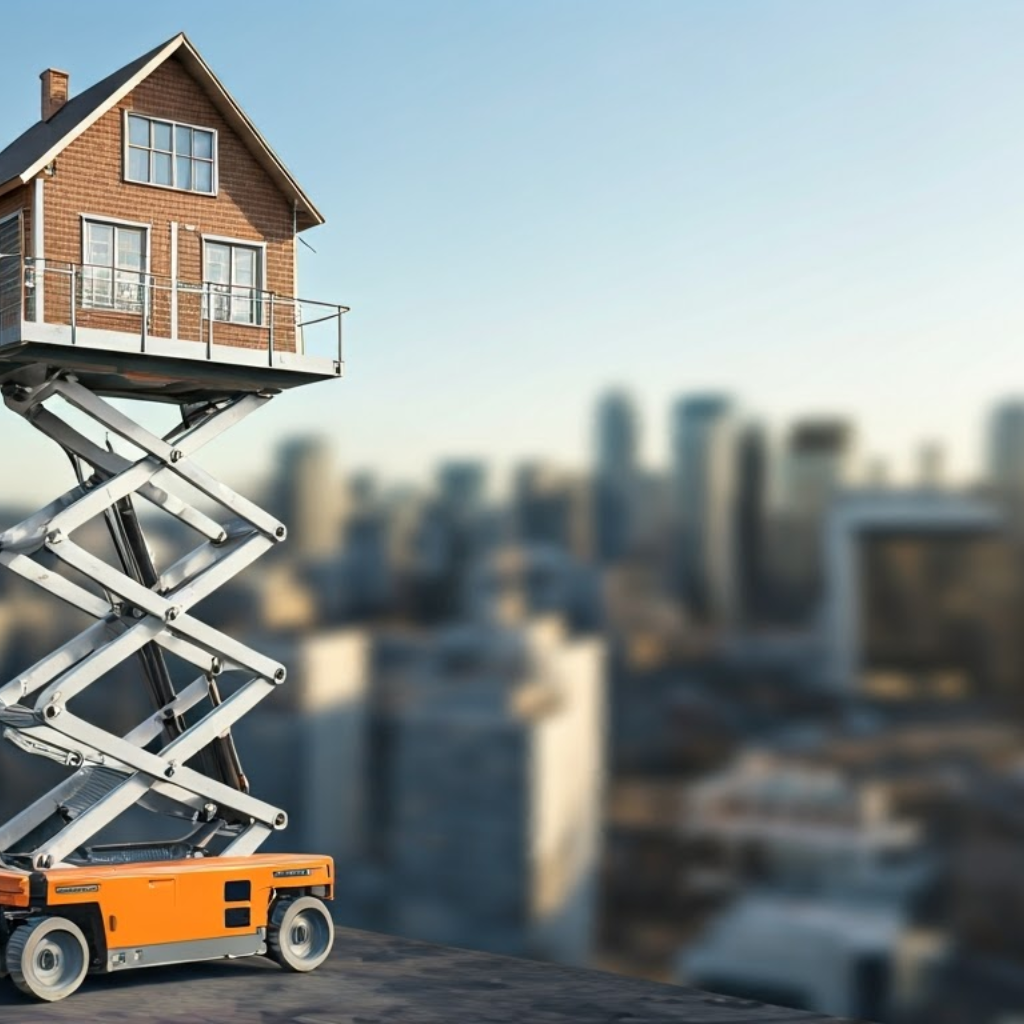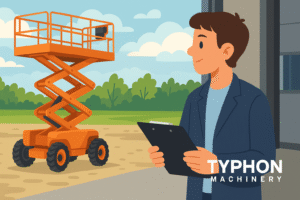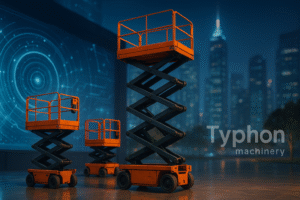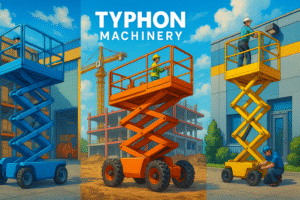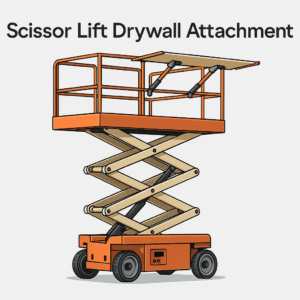Beyond following guidelines, scissor lift safety is the most important measure to preserve lives. The best approach to guarantee scissor lift safety is to always follow OSHA standards and have a working safety policy. Do you use and maintain scissor lifts at work?
Operators, supervisors, and safety managers should learn proper safety procedures. In 2025, this complete article will include all OSHA-approved scissor lift operator standards. The rules for fall protection systems and emergency processes were reviewed, but we added useful insights.
Will you collaborate to make the workplace safer and prevent accidents? The following safety guidelines, drawn from personal style and broad experience, will secure your safety when operating scissor lifts and give you the confidence to do so with accuracy and dexterity.
Key Takeaways:
Scissor lift operators must have safety harnesses as well as the right guardrails to ensure that they are safe from any accident.
Regular inspection of equipment and proper maintenance are very important because this will help to identify risks faster and will also ensure that the equipment is repaired for concurrent usage of scissor lifts without any hazard occurrence.
- The requirements of the training and certification of the operator are very essential in preventing occurrences of accidents by the untrained operator.
- The establishment’s safety plan needs to include rules for the correct equipment layout, consideration of the weather, and attention to the surrounding hazards.
- Personal protective equipment (PPE) and fall restraint systems are two important devices of the scissor lift safety
- Understanding load requirements, keeping the surface stable, and knowing emergency procedures are the basic steps for safe operations
Knowing Scissor Lift Safety Fundamentals
The entire safety philosophy of a workplace starts with your sound familiarity with the machinery you manage. That is to say, when a scissor lift is your concern, knowing the parts of it and what they do are of utmost importance to your safety.
- Major Parts of a Scissor Lift
First and foremost, you must grasp the most vital scissor lift facts to perform safely. Stay sharp about the bottom, where to install the platform, power system, and controls, which is the equipment’s sturdy base. The scissor lift’s vertical movement is caused by the ‘X’ structure of crossed steels.
Operators work on the platform. Guardrails prevent falls and prevent the equipment from shaking, making them crucial to safety. Height and x-y axis movement may be precisely adjusted via the platform’s control panel.
- Most scissor lifts now include tilt sensors, panic buttons, and overload warnings.
- This group of elements controls the scissor lift and prevents mishaps. Outriggers or stabilizers support the lift’s side from the base, adding stability.
- Understanding how these components operate together is crucial to worker safety. The equipment stays intact and avoids mechanical failures and accidents if its emergency systems and structural components are tested at regular intervals.
- The designs of different models vary, although most have the same essential characteristics. Awareness of each piece of equipment can help you see early signs of issues and avoid harmful situations.
💡 Key Takeaway: Familiarity with the principal parts of a scissor lift, starting with the base and up to the safety features, is the very foundation of ensuring workplace safety. It is imperative to follow all safety rules during lift operation to prevent workplace accidents.
- Lift Operator’s Training and Certification Requirements
A trained and certified lift operator is the most important element in guaranteeing fidelity to strict safety policies and at the same time being confident that the accident will be kept to a minimum.
Thus, with the right training, the workers have an understanding of safety protocols, the necessary safety equipment, and the right operation of scissor lift.
Training Elements required for Licensing the Operator
OSHA dictates an elaborate training program for anyone who operates a scissor lift. The key point is that the training must comprise of theoretical knowledge related to the subject as well as the practical aspect as well. It is well-known that the employee who has not undergone the needed training is a potential danger to himself and to his workmates, not to say the least.
The training plan should involve the following points:
- Machine orientation and controls
- The procedure of pre-operation inspection
- Workplace hazard recognition
- Load capacity limitations
- Safe operating procedures
- Emergency protocols and rescue plans
- Manufacturer’s safety guidelines
- Fall protection requirements
Employers have to be the key in organizing a qualified instructor to provide training to the workers and the instructor should be experienced in scissor lift operation. The training must be noted and be a balance of theoretical and practical aspects.
Training is what an operator needs to stay competent, which is not a one-time thing and is not really possible without the courses, just the same with continuing education for other professions. It is recommended that they would take place:
- When new equipment is introduced
- After accidents or near-misses
- When operators show signs of unsafe operation
- At least every three years
All the training records need to be kept on file and should include:
- Date of training
- Name of operator
- Type of equipment covered
- Name of instructor
- Assessment results
The operator’s success in the training program is a strong indicator of whether or not the operator can be trusted with the responsibility of being in charge of the operation, and thus, should be given a certificate. The certification will be needed by an authorized agent to confirm identification and competence during the inspection.
💡 Key Takeaway: A full-blown driver’s training program is unavoidable if a person is to undergo a scissor lift operation, including both theory and practice sessions; in addition, there should be constant checks or the documentation pool for safety compliance.
- Fall Protection Systems and Requirements
Using fall protection systems is very important because they are what keep a worker from the hazards of the operation of scissor lifts. Even though guardrails protect the workers in almost all of the workplace situations considered, certain specific cases demand the presence of some complementary safety system to avoid undesirable consequences.
Essential Fall Protection Devices
A crucial apparatus for safety while scissor lifts are employed, especially in situations where existing guardrails do not provide adequate protection, is a personal fall arrest system. This system is made up of three main components that all together ensure the safety of a person at the highest level:
- Anchor Points
- The attachment points should be designed in such a way that they can handle 5,000 pounds per worker attached
- The best practice is to place the anchor points above the worker’s head whenever it is possible
- The anchors of any other platform used for supporting the scissor lift operation must not be used
- Body Support
- The whole-body safety harness is obligatory
- The harness must be well-fitted and regularly checked
- All straps must be securely fastened, i.e., no loose ends are tolerated
- Connecting Devices
- Harness energy-absorbing lanyards or self-retracting lifelines
- Ensure the correct length to avoid contact with the lower levels
- Regular inspections are required for all connecting parts
Suppose workers use fall protection systems. They have to make sure the fall arrest equipment matches the scissor lift model they are working on. Regular checks of all components before each use will help the safety system not to be compromised.
It is important to realize that 100% tie-off must be maintained if necessary and these should not be anchored to adjacent poles, structures, or equipment. The fall protection system has to give the workers maximum mobility while keeping them safe throughout the working procedure.
💡 Key Takeaway: A well-defined fall protection system that is maintained properly is equipped with a safe fall arrest system that has a well-anchored point as well as a full-body harness and a suitable connecting device and thus is the most essential thing to remember in terms of the safety of scissors elevating platforms.
- Pre-Operation Safety Inspections
Conducting a pre-operation safety inspection procedure before using the aerial work platform is indispensable to maintain workplace safety and prevent injuries. Regular scissor lift inspections can prevent potential problems by identifying them at an early stage.
Daily Inspection Checklist
These checks are indispensable if you want to make your workday hassle free and secure:
- Yes, test emergency stop controls and life-saving systems
- Check if the platform floor has slip hazards, debris, or damage
- Confirm that battery charge levels and hydraulic fluid levels are satisfactory
- Check for proper tire inflation and look for signs of wear on the tires
- Ensure there are no missing or loose parts
- Verify if brakes and steering mechanisms are in good condition
- Confirm all control functions are in good working order
- Find out how far warning devices and alarms are working
- Search for any hydraulic leaks or broken hoses
A thorough inspection should also be extended to the immediate work area to find sources of hazards such as:
- The presence of overhead obstacles or power lines has been verified.
- Occurrence of ground conditions and surface stability have been detected.
- What kinds of weather-related risks are present?
- Whether the traffic is of normal patterns and pedestrians are not affected?
- Equipment located adjacent to or similar to it
Collect all discoveries in the maintenance record and instantly let your supervisor know of any problems identified. Under no circumstances should you use a scissor lift which is seemingly defective.
Keep in mind that the checks are not just a legal requirement but also a necessary step to the workers’ protection and the long life of the equipment. Decide that the pre-operation checks are the part of your daily habits that you are not willing to give up.
💡 Key Takeaway: Inspecting scissor lifts daily before operating them and noting the results not only lead to the early detection of potential hazards, but also support the safe and standard operation of the machine.
- The Management of Standard Regulations
Regularity in following the industrial standards is very vital in the use of scissor lifts, which guarantees safety of workers and prevents unwanted financial penalties. Due to the continuous change in the regulation, it becomes necessary for the organizations to be always updated with the new regulations.
OSHA Safety Guidelines:
The most significant representative of occupational safety and health in the United States of America – The Occupational Safety and Health Administration (OSHA) collaborates with the American National Standards
Institute to publish standards for operating scissor lifts that are more comprehensive and safer. Such standards take into consideration new safety issues as well as improvements in equipment design due to new technological advances.
Organizations need to be always concerned with compliance issues if they want to avoid being issued with a costly OSHA fine levied by the regional office, ranging from several thousand to several tens of thousands of dollars per violation. Besides that, the Indiana Department of Labour summarizes that the abidance to these guidelines does not only exempt employers from the penalties, but also it is a guarantee of the safety of the employees hence creating a safer work environment.
Recently, new rules from OSHA have brought in more stringent requirements like:
- Regular inspections of equipment and maintenance documentation
- Operator training and certification programs
- The fall protection systems and guardrail specifications
- The load capacity limitations, and stability requirements
- Emergency response procedures
For further on this, companies must run safety awareness programs in the organization that fit with these standards. This means they have to keep records on training sessions, equipment inspection, and any incidents or near-misses that occur during operation.
Safety protocols should be the subject of regular checks to quality and equitable practice. Moreover, the organizations should create clear communication links with the authorities in charge to know of new or upcoming requirements after changes in safety protocols.
💡 Key Takeaway: Conforming with OSH and industry regulations is a continuous process that calls for consistent attention, definite updates to safety protocols, and appropriate documentation to avoid financial penalties and at the same time ensure employees’ safety.
Final Safety Share:
OSHA-compliant scissor lift safety requirements are essential for workplace safety and employee injury prevention. With proper training, timely inspections, and fall protection measures, you can reduce risky events and comply with safety laws.
Understanding that safety is not about compliance but about workplace responsibility where operators, supervisors, and safety managers emphasize workplace welfare. From harness standards to weather concerns, safety is essential to avoiding accidents and ensuring smooth operations.
Accept better scissor lift safety now. Implement these rules, follow OSHA standards, and train operators thoroughly. Your attention to safety keeps your employees safe and productive while following the law. Please work together to make scissor lift operations safer.
FAQs
What is the maximum wind speed at which a scissor lift can safely operate?
It is an unacceptable practice to run a scissor lift in winds that are more than 28 mph (12.5 m/s) which is the recommended limit stated by manufacturers. At the same time, do not just believe this figure and try to find it out from the manual of your equipment for you never know the limits there may be. Strong winds is a major cause of scissor lift instability and provide risky working conditions.
How often should scissor lift operators receive refresher training?
OSHA requires refresher training to be given to the forklift operators at least every three years after their initial training and it should be done immediately there are any workplace incidents, near misses or when the operators fail to demonstrate adequate knowledge. The training program inclusion regular occurs when employees are educated on safety protocols; whenever they are competent in that, then the system is updated with the new technologies in the industry. It doesn’t matter even if they have been in it for long without updating their skills.
Can multiple workers use a scissor lift simultaneously?
Yes, it is possible to use the lift by more than one worker as long as the load doesn’t exceed the manufacturer’s weight restriction, which is exclusive of the weight of the tools and materials. Having said that, the platform must be big enough to allow them to move and work there without any hitch.
What should operators do if they notice hydraulic fluid leaks?
The first thing to do is to discover if there are any hydraulic fluid leaks; if they exist, then the immediate action to take would be to stop the lift and if necessary, lower the lift. After that, the machine should be tagged out of use, and the authority should be informed of its condition. There will never be a time when a person should use a lift with hydraulic fluid leaks as this behavior will only complicate everything, that is to say, the platform becomes unstable which is hazardous.
Are scissor lifts safe to use on slopes or inclined surfaces?
Scissor lifts must be used in a situation where the ground is suitable, the surface level is firm, and the terrain does not allow the infiltration of water. It is recommended that the angle of inclination of the slope not exceed 3 degrees. One should always observe the recommendations made by the manufacturer and also use outriggers and/or leveling devices if one is not sure of the stability of the lift in use.
What fall restraint systems and fall arrest systems for scissor lifts are like different?
Being confined to the platform, fall restraint systems remove the possibility of falls, while fall arrest systems are for situations where falls have already happened and are meant to execute the process of stoppage. With regard to scissor lifts, it is common for OSHA to suggest a fall restraint system mainly because these are the kind of systems that are more effective in avoiding workers from drop accidents.

